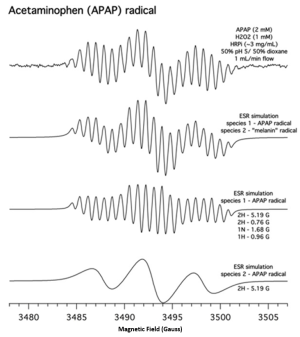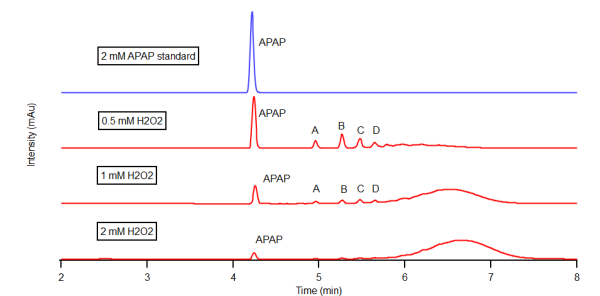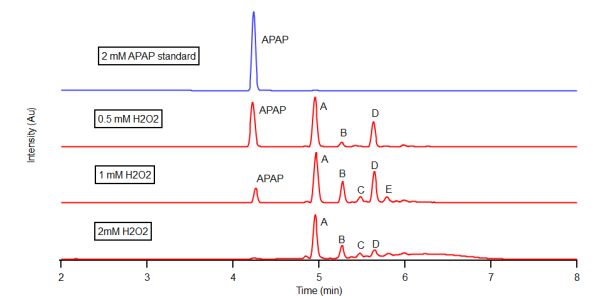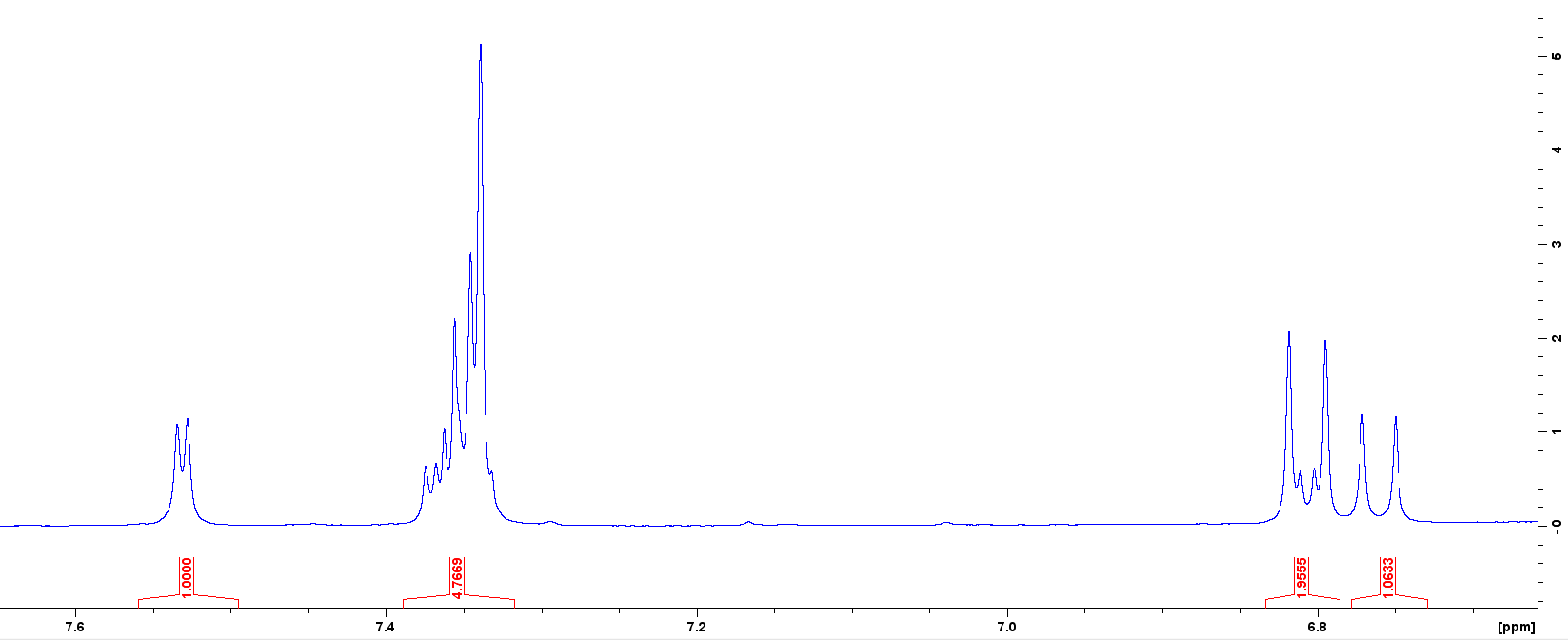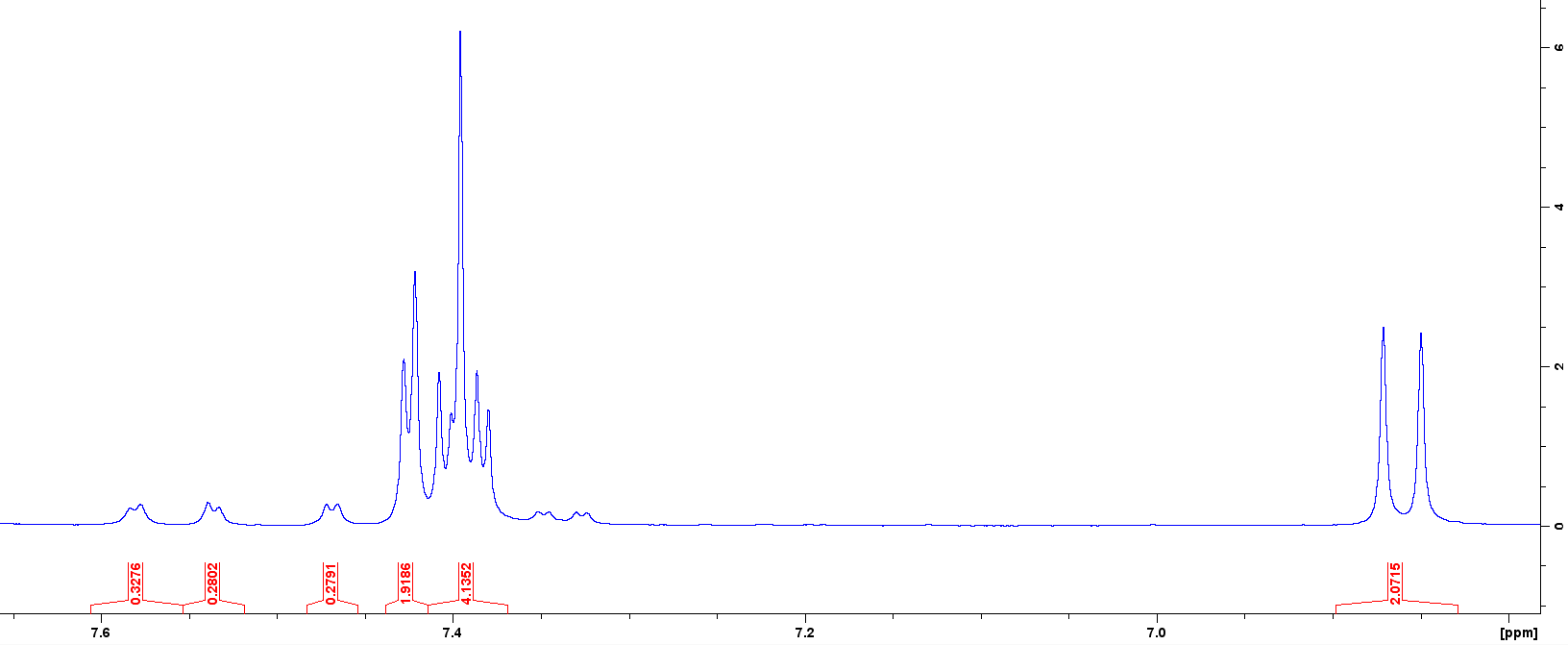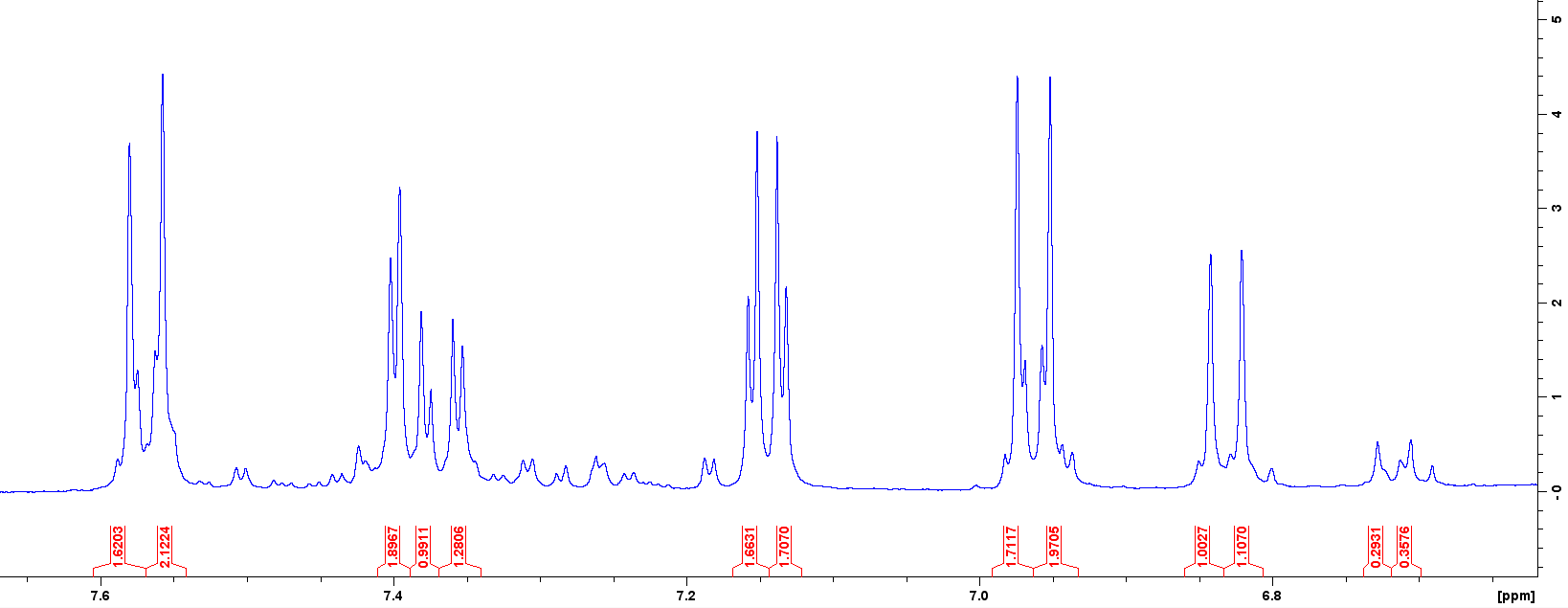Difference between revisions of "Acetaminophen Manuscript"
| Line 49: | Line 49: | ||
'''Mass Spectrometry of Acetaminophen Metabolites''' | '''Mass Spectrometry of Acetaminophen Metabolites''' | ||
| − | :[[File:qTOF-MS_Figure.png| | + | :[[File:qTOF-MS_Figure.png|600px]] [[File:qTOF-MS_table.png]] |
| − | + | :RERUN MS using HPLC in order to get more peaks | |
:The data represents a partial set of MS molecular ions as a result of the | :The data represents a partial set of MS molecular ions as a result of the | ||
:flash chromatography purified oxidation products isolated from the APAP/H2O2/HRP | :flash chromatography purified oxidation products isolated from the APAP/H2O2/HRP | ||
Revision as of 20:17, 20 January 2022
This page is being prepared to submit a manuscript for peer review and publication in the Journal of Chemical Research in Toxicology by Matthew Simonson. The goal of this work is to provide foundational evidence for a mechanism of hepatotoxicity caused by radical polymerization of Acetaminophen within the liver as opposed to soley a mechanism of two electron oxidation into NAPQI.
Title Page
- A brief and informative title (preferably fewer than 12 words) will aid in the classification and indexing of the paper. Do not use trade names of drugs, jargon, or abbreviations. Include keywords. List full names and institutional affiliations of all authors, and if differentiation is necessary, indicate the affiliations of each author by the superscript symbols †, ‡, §, ║, ┴, etc. These symbols should also be used to indicate author affiliations different from those stated on the title page and present address information. The author to whom correspondence should be addressed is indicated by an asterisk. It is implicit in listing a person as an author that this individual has agreed to appear as an author of the manuscript.
Table of Contents Graphic
- A Table of Contents (TOC) graphic is published with each manuscript. It is submitted for use in the table of contents and is also used for multiple purposes, including the document abstract and other situations where a representative graphic is required. Create an image that represents the work while adhering to size constraints. Keeping in mind that various devices may be involved, some of the best images are simple, relatively free of text and technical characters, and make use of color for visual impact. It is best to avoid complex structure schemes and small-sized details. The author must submit a graphic in the actual size to be used for the TOC that will fit in an area 8.47 cm by 4.76 cm (3.33 in. by 1.88 in.). Larger images will be reduced to fit within those dimensions. Type size of labels, formulas, or numbers within the graphic must be legible at the specified size. Tables or spectra are not acceptable. Place the TOC graphic after the title page and before the abstract page of the manuscript. All elements of the TOC graphic must be (1) entirely original and (2) created by one or more of the authors. Lastly, this graphic should have no legend.
Abstract
- An abstract should be included with all Articles, Communications, Chemical Profiles, Reviews, and Perspectives. For Articles, Communications, and Chemical Profiles, the abstract should briefly (300 word maximum) present, in one paragraph, the problem and experimental approach and state the findings and conclusions. For Reviews and Perspectives, the abstract should introduce the topic, summarize key points, and state the major conclusions. In all cases, the abstract should be self- explanatory and suitable for reproduction without rewriting. Footnotes or undefined abbreviations may not be used. Avoid the use of jargon, but include keywords relevant to the field to improve indexing and discoverability to potential readers. If a reference must be cited, complete publication data must be given.
- Acetaminophen (APAP) is a common analgesic and an active ingredient in many painkillers such as Tylenol and Percocet. Upon overdose, APAP can lead to toxicity in the liver, which accounts for a striking proportion of acute liver failures in the United States annually. Considering the potential for APAP induced hepatotoxicity, our research group has analyzed APAP and its tendency to oxidize into reactive products through both enzymatic and electrochemical methods of in vitro oxidation, which was visualized through HPLC. Characterization of these APAP oxidation products were carried out using electron spin resonance (ESR), quadruple time-of-flight mass spectrometry (qTOF-MS), 400 MHz proton nuclear magnetic resonance (H-NMR), and cyclic voltammetry (CV). Our findings provide structural insight into potentially deleterious APAP oxidation metabolites formed in the liver during times of APAP overdose formed via a mechanism of radical polymerization.
Introduction
- The introduction should state the purpose of the investigation and its relation to other work in the field. Background material should be brief and relevant to the research described. Detailed or lengthy reviews of the literature should be avoided.
IUPAC NAMES for Acetaminophen (APAP), paracetamol, and intermediates
- Introduce APAP and Toxicity
- Acetaminophen (APAP) is one of the most widely used analgesics and antipyretics. Similarly, APAP overdose remains to be a large problem in the United States and is responsible for a majority of the acute liver failures annually (Lee at al; Bernal et al).
- Introduce NAPQI, Conjugation, and GSH Depletion
- While APAP itself is harmless, APAP metabolic pathways have been investigated by numerous studies which allude to reactive metabolites of APAP being responsible for liver necrosis. The commonly accepted mechanism of APAP induced hepatotoxicity revolves around a suggested two electron oxidation of APAP into the electrophilic metabolite, NAPQI, via Cytochrome P450 enzymes (CYPs) (Gillette et al. 1981). NAPQI was determined to be the main deleterious metabolite of APAP oxidation in the liver through indirect measurement of its conjugation and detoxification with glutathione (Dahlin et al. 1984). The oxidation of APAP occurs in a dose dependent manner and leads to the depletion of intracellular glutathione levels (???). The hepatotoxic effects occur only after intracellular glutathione levels have been depleted (???); however, studies concerning diethyl maleate, which depletes hepatic glutathione without causing toxicity, signified that glutathione depletion is not the direct cause of hepatotoxicity (Mitchell et al. 1973a, b). Clinical data of APAP conjugation with protein thiol groups is highly correlated to severity of hepatotoxicity (???). Still, there is significant evidence that suggests that covalent binding is not the mechanism of hepatotoxicity (???). This leads to the ...
- Introduce 1e- Oxidation Potential and CYP Ability to do this.
- Moreover, CYPs have been suggested to catalyze APAP through both a one electron oxidation and a two electron oxidation mechanisms (Potter and Hinson 1987). Oxidation reactions mediated by CYPs involving phenols have been confirmed to occur by both mechanisms of single electron transfers and hydrogen atom transfers (HATs) (???). This could provide grounds for an alternatively toxic metabolism of APAP other than NAPQI, produced via a SAT mechanism followed by radical polymerization. Investigation into such metabolites could shed light on the controversial topic of how APAP induced liver necrosis disseminates. Considering that, the purpose of this work is to revisit the oxidation of APAP at the molecular level by synthesizing and then characterizing its metabolites in order to consider an alternative mechanism of APAP induced liver injury.
Experimental Procedures
- Procedures for experimental methods should be described in sufficient detail to enable other investigators to repeat the experiments. Names of product manufacturers (with city, state address, catalog number) should be included if alternate sources are deemed unsatisfactory or if the product is of limited availability. Novel experimental procedures should be described in detail, but previously published procedures should be referred to by literature citation of the original detailed explanation, and should include description of any modifications.
Results
- The results should be presented concisely. Tables and figures should be designed to maximize the presentation and comprehension of the experimental data. The same data should not be presented in more than one figure or in both a figure and a table. Detailed interpretation of results should be reserved for the discussion section of an Article.
Electron Spin Resonance of Radical Acetaminophen Intermediate
Enzymatic Oxidation of Acetaminophen
- The enzymatic oxidation of APAP was observed by reverse phase HPLC with a diode array detector set at 270 nm in a 25% dioxane - pH 7 buffer on the left and a 25% dioxane - pH 9 buffer on the right. The chromatogram on top (blue) serves as a 2mM APAP standard prior to reaction. Increasing concentrations of H2O2 were reacted within the APAP/H2O2/HRP system with each red chromatogram down. These concentrations were 0.5mM, 1mM, and 2mM H2O2 respectively. Results indicate the formation of chemically unique products present at both pH 7 and 9, A, B, C, D. However, the formation of these products were maximized in the pH 9 buffer. As H2O2 concentration rose within the pH 7 buffer, increasingly nonpolar products grew in concentration as signified by the hump in the 6-7 minute range.
Electrochemical Oxidation of Acetaminophen
Mass Spectrometry of Acetaminophen Metabolites
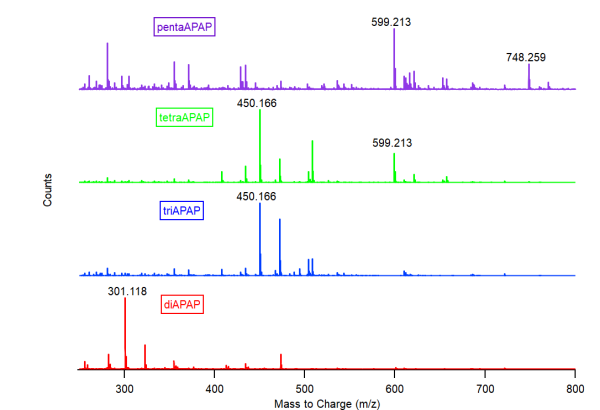
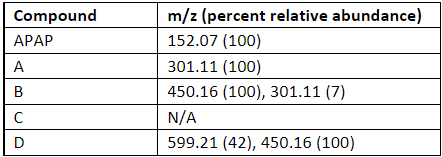
- RERUN MS using HPLC in order to get more peaks
- The data represents a partial set of MS molecular ions as a result of the
- flash chromatography purified oxidation products isolated from the APAP/H2O2/HRP
- oxidation reaction. ESI-MS data are m/z + 1 and contain relative abundance of
- each molecular ion.
Nuclear Magnetic Resonance of Early Acetaminophen Metabolism
Discussion
- The purpose of the discussion is to interpret the results and to relate them to existing knowledge in the field in as clear and brief a fashion as possible. Information given elsewhere in the manuscript should not be repeated in the discussion. Extensive reviews of the literature should be avoided.
Funding Information
- Authors are required to report ALL funding sources and grant/award numbers relevant to this manuscript. Enter all sources of funding for ALL authors relevant to this manuscript in BOTH the Open Funder Registry tool in ACS Paragon Plus and in the manuscript to meet this requirement. See http://pubs.acs.org/page/4authors/funder_options.html for complete instructions.
Acknowledgment
- This section should acknowledge technical assistance, advice from colleagues, gifts, etc. Permission should be sought from persons whose contribution to the work is acknowledged in the manuscript.
Abbreviations
- Abbreviations are used in ACS Journals without periods. Standard abbreviations should be used throughout the manuscript. All nonstandard abbreviations should be kept to a minimum and must be defined in the text following their first use.
Footnotes
- When footnotes are necessary to express some relevant thoughts, these should be included as a parenthetical statement, placed next to the related text to ensure visibility. Footnotes should not be included in the reference list.
Tables
- Tabulation of experimental results is encouraged when this leads to more effective presentation or to more economical use of space. Tables may be created using a word processor’s text mode or table format feature. The table format feature is preferred. Ensure each data entry is in its own cell; no listing of data by using bullets or numbering. If the text mode is used, separate columns with a single tab and use a line feed (return) at the end of each row. Tables should be numbered consecutively with Arabic numerals. Provide a brief title with each table and a brief heading for each column. Clearly indicate the units of measure (preferably SI). Data should be rounded to the nearest significant figure. Explanatory material referring to the whole table is to be included as a footnote to the title (a). Footnotes in tables should be given lower case letter designations and cited in the tables as italicized superscripts. All tables should be cited in the text in consecutive order.
Previously published tables that are being borrowed or adapted from another source require permission from the copyright holder. Once permission is obtained, the permission letter should be uploaded to the submission under the tag “Other Files for Editors Only.” Also, the copyright holder’s preferred credit line should be included in the table’s legend.
Figures and Figure Legends. Line drawings, graphs, stereograms, histograms, and black and white (or color) photographs are all classified as figures and should be numbered consecutively with Arabic numerals in order of citation. Figure legends should be placed after the tables as a single list with the figures following. The figures must be embedded in the same document as the article and not submitted separately as Supporting Information. It may help to print the manuscript on a laser printer to ensure all artwork is clear and legible. See below for guidelines for preparing publication quality illustrations.
- Authors Photos and Biographies. All authors of Reviews and Perspectives (but not other publication formats) should provide a short biography (100 words or less) to be published with the articles.
Headshots (i.e., photos) of the authors may also be provided for publication with the biography. Photos and accompanying biography should be inserted below the reference list in the manuscript. Each photo must be high resolution (at least 300 ppi). No logos may appear in the photo. Before publication, each author must sign (1) a Model Release Form and (2) either a Copyright Transfer Form, which transfers copyright to ACS, or the Nonexclusive Rights Agreement, by which the copyright holder keeps the copyright but grants ACS permission to use the photo. Please choose either the Copyright Transfer Form or the Nonexclusive Rights Agreement; do not sign both forms.
